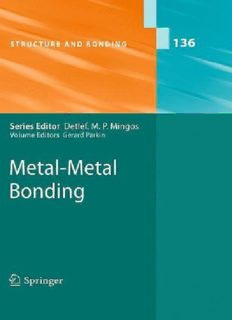
Metal-metal bonding PDF
Preview Metal-metal bonding
136 Structure and Bonding Series Editor: D. M. P. Mingos Editorial Board: · · · P. Day X. Duan L.H. Gade K.R. Poeppelmeier · G. Parkin J.-P. Sauvage Forfurthervolumes: http://www.springer.com/series/430 Structure and Bonding SeriesEditor:D.M.P.Mingos RecentlyPublishedandForthcomingVolumes Metal-Metal Bonding OrganometallicandCoordination VolumeEditor:Gerard Parkin ChemistryoftheActinides Vol.136,2010 VolumeEditor:Albrecht-Schmitt,T.E. Vol.127,2008 Functional Phthalocyanine Molecular Materials HalogenBonding VolumeEditor:Jianzhuang Jiang FundamentalsandApplications Vol.135,2010 VolumeEditors:Metrangolo,P.,Resnati,G. Vol.126,2008 Data Mining in Crystallography VolumeEditors:Hofmann, D. W. M., HighEnergyDensityMaterials Kuleshova, L. N. VolumeEditor:Klapötke,T.H. Vol.134,2010 Vol.125,2007 ControlledAssemblyandModification Ferro-andAntiferroelectricity ofInorganicSystems VolumeEditors:Dalal,N.S., VolumeEditor:Wu,X.-T. Bussmann-Holder,A. Vol.133,2009 Vol.124,2007 MolecularNetworks PhotofunctionalTransitionMetal VolumeEditor:Hosseini,M.W. Complexes Vol.132,2009 VolumeEditor:V.W.W.Yam Vol.123,2007 MolecularThermodynamics Single-MoleculeMagnets ofComplexSystems andRelatedPhenomena VolumeEditors:Lu,X.,Hu,Y. VolumeEditor:Winpenny,R. Vol.131,2009 Vol.122,2006 ContemporaryMetalBoronChemistryI Non-CovalentMulti-PorphyrinAssemblies VolumeEditors:Marder,T.B.,Lin,Z. SynthesisandProperties Vol.130,2008 VolumeEditor:Alessio,E. Vol.121,2006 RecognitionofAnions VolumeEditor:Vilar,R. RecentDevelopmentsinMercuryScience Vol.129,2008 VolumeEditor:Atwood,DavidA. Vol.120,2006 LiquidCrystallineFunctionalAssemblies andTheirSupramolecularStructures LayeredDoubleHydroxides VolumeEditor:Kato,T. VolumeEditors:Duan,X.,Evans,D.G. Vol.128,2008 Vol.119,2005 Metal-Metal Bonding Volume Editor: Gerard Parkin With contributions by · · · · B.B. Averkiev J.F. Berry A.I. Boldyrev T. Cadenbach · · · · M.H. Chisholm R.A. Fischer G. Frenking C. Gemel S. Gonzalez-Gallardo· M.S. Hill · v. Hopffgarten · C. Ni·G. Parkin · P. P. Power· G. Prabusankar · A.P. Sergeeva · C.A. Tsipis 123 Prof.Dr.Gerard Parkin Columbia University Dept. Chemistry 3000 Broadway New York NY 10027 USA [email protected] ISSN0081-5993 e-ISSN1616-8550 ISBN978-3-642-05242-2 e-ISBN978-3-642-05243-9 DOI10.1007/978-3-642-05243-9 SpringerHeidelberg Dordrecht LondonNewYork LibraryofCongressControlNumber:2009943436 (cid:2)c Springer-VerlagBerlinHeidelberg2010 Thisworkissubjecttocopyright.Allrightsarereserved,whetherthewholeorpartofthematerialis concerned,specificallytherightsoftranslation,reprinting,reuseofillustrations,recitation,broadcasting, reproductiononmicrofilmorinanyotherway,andstorageindatabanks.Duplicationofthispublication orpartsthereofispermittedonlyundertheprovisionsoftheGermanCopyrightLawofSeptember9, 1965,initscurrentversion,andpermissionforusemustalwaysbeobtainedfromSpringer.Violations areliabletoprosecutionundertheGermanCopyrightLaw. Theuseofgeneral descriptive names,registered names, trademarks, etc. inthis publication does not imply,evenintheabsenceofaspecificstatement,thatsuchnamesareexemptfromtherelevantprotective lawsandregulationsandthereforefreeforgeneraluse. Coverdesign:KünkelLopka GmBH, Heidelberg, Germany Printedonacid-freepaper SpringerispartofSpringerScience+BusinessMedia (www.springer.com) Series Editor Prof.D.MichaelP.Mingos Principal St.EdmundHall OxfordOX14AR,UK [email protected] Volume Editor Prof.Dr.Gerard Parkin Columbia University Dept. Chemistry 3000 Broadway New York NY 10027 USA [email protected] Editorial Board Prof.PeterDay Prof.Dr. Kenneth R. Poeppelmeier DirectorandFullerianProfessor DepartmentofChemistry ofChemistry Northwestern University TheRoyalInstitutionofGreatBritain 2145 Sheridan Road 21AlbermarleStreet Evanston, IL 60208-3133 LondonW1X4BS,UK USA [email protected] [email protected] Prof.XueDuan Prof.GerardParkin Director DepartmentofChemistry(Box3115) StateKeyLaboratory ColumbiaUniversity ofChemicalResourceEngineering 3000Broadway BeijingUniversityofChemicalTechnology NewYork,NewYork10027,USA 15BeiSanHuanDongLu [email protected] Beijing100029,P.R.China [email protected] Prof.Jean-PierreSauvage FacultédeChimie Prof.LutzH.Gade LaboratoiresdeChimie Anorganisch-ChemischesInstitut Organo-Minérale UniversitätHeidelberg UniversitéLouisPasteur ImNeuenheimerFeld270 4,rueBlaisePascal 69120Heidelberg,Germany 67070StrasbourgCedex,France [email protected] [email protected] Structure and Bonding Also Available Electronically Structure and Bonding is included in Springer’s eBook package Chemistry and Materials Science. If a library does not opt for the whole package the book se- ries may be bought on a subscription basis. Also, all back volumes are available electronically. For all customers who have a standing order to the print version ofStructure and Bonding,weoffertheelectronicversionviaSpringerLinkfreeofcharge. If youdonothaveaccess, youcan still view thetable of contentsof eachvolume andtheabstractofeacharticlebygoingtotheSpringerLinkhomepage,clickingon “ChemistryandMaterialsScience,”underSubjectCollection,then“BookSeries,” underContentTypeandfinallybyselectingStructureandBonding. Youwillfindinformationaboutthe – EditorialBoard – AimsandScope – InstructionsforAuthors – SampleContribution atspringer.comusingthesearchfunctionbytypinginStructureandBonding. ColorfiguresarepublishedinfullcolorintheelectronicversiononSpringerLink. Aimsand Scope The series Structure and Bonding publishes critical reviews on topics of research concernedwith chemicalstructure andbonding.The scopeof the series spansthe entirePeriodicTableandaddressesstructureandbondingissuesassociatedwithall of the elements. It also focuses attention on new and developingareas of modern structuraland theoreticalchemistry such as nanostructures,molecular electronics, designed molecular solids, surfaces, metal clusters and supramolecularstructures. Physicalandspectroscopictechniquesusedtodetermine,examineandmodelstruc- turesfallwithinthe purviewof StructureandBondingtothe extentthatthe focus isonthescientificresultsobtainedandnotonspecialistinformationconcerningthe techniquesthemselves.Issuesassociatedwith thedevelopmentofbondingmodels and generalizations that illuminate the reactivity pathways and rates of chemical processesarealsorelevant. The individual volumes in the series are thematic. The goal of each volume is to give the reader, whether at a university or in industry, a comprehensive overview ofanareawherenewinsightsareemergingthatareofinteresttoalargerscientific audience.Thuseachreviewwithinthevolumecriticallysurveysoneaspectofthat topicandplacesitwithinthecontextofthevolumeasawhole.Themostsignificant developmentsofthelast5to10yearsshouldbepresentedusingselectedexamples toillustrate theprinciplesdiscussed.A descriptionofthephysicalbasisofthe ex- perimentaltechniquesthathavebeenusedtoprovidetheprimarydatamayalsobe appropriate,ifithasnotbeencoveredindetailelsewhere.Thecoverageneednotbe exhaustiveindata,butshouldratherbeconceptual,concentratingonthenewprin- ciplesbeingdevelopedthatwillallowthereader,whoisnotaspecialistinthearea covered, to understand the data presented. Discussion of possible future research directionsintheareaiswelcomed. Reviewarticlesfortheindividualvolumesareinvitedbythevolumeeditors. In references Structure and Bonding is abbreviated Struct Bond and is cited as a journal. ImpactFactorin2008:6.511;Section“Chemistry,Inorganic&Nuclear”: Rank2of40;Section“Chemistry,Physical”:Rank7of113 Preface Despite the factthatcompoundsthatfeaturemetal–metalbondshavebeenknown for many decades, interesting discoveries continue to be made at a rapid pace. The purpose of this volume is to highlightsome of these recent advancesin both maingroupandtransitionmetalchemistry,andanoverviewofthetopicscoveredis providedhere. Berry describestransition metalcompoundsin which there are chainsof metal atoms. Such compounds are often considered as potential molecular wires for molecular electronic applications and the conductance of these compoundsat the molecular level is discussed. In addition to compoundsthat feature homometallic chains,thosewithheterometallicchainsarealsodescribed. Chisholmdescribesadifferentapproachtolinkingtogethermetalcenters,namely one in which quadruply bonded dimolybdenumand ditungsten moieties are elec- tronically coupled via a conjugated (cid:2)-system of an organic bridging ligand. The types of structures obtained include loops, triangles and squares of the dinuclear moieties. Ni and Power describe the use of sterically demanding terphenyl ligands to synthesizetransitionmetaldinuclearcompoundsoftypeArMMArthathaveexcep- tionallyshortM–MbondsandhighM–Mbondorders.Forexample,ArCrCrAris describedaspossessingaquintupleCr–Crbond. Theevaluationofthemetal–metalbondorderisoftenanimportantcomponentin thedescriptionofcompoundswithmetal–metalbonds,andParkinevaluatesthevar- iouselectron-countingproceduresthatareusedtopredictmetal–metalbondorders intransitionmetalcompoundsthatfeaturebridginghydrideandalkylligands. Attheinterfaceofmaingroupandtransitionmetalchemistry,Frenking,Fischer etal.describerecentdevelopmentsinwhichmonovalentgalliumspeciescanserve asligandsfortransitionmetals,therebyaffordingavarietyofcompoundsthatfea- ture M–Ga bonds.Furthermore,many of these compoundswith M–Ga bondscan beconvertedintocompoundsthatfeatureM–Znbonds.Also,withrespecttomain group chemistry, Hill discusses catenated compounds of Group 13–15 elements, whichfeaturechainsofM–Mbonds. ix x Preface Finally,theconceptofaromaticityandantiaromaticityincompoundsthatfeature rings of metal atoms is discussed by Tsipis, who focuses on rings of main group metalatoms,andbyBoldyrevetal.,whofocusontransitionmetalcompounds. NewYork GerardParkin January2010
Description: